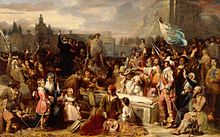| First Bishops' War | |||||||
|---|---|---|---|---|---|---|---|
| Part of the Bishops' Wars | |||||||
 Signing of the National Covenant in Greyfriars Kirkyard, Edinburgh | |||||||
| |||||||
| Belligerents | |||||||
|
|
| ||||||
| Commanders and leaders | |||||||
|
|
| ||||||
| Irish forces under Randal MacDonnell, 1st Marquess of Antrim also mustered but played no part in the campaign. | |||||||
The First Bishops' War was a conflict between Scottish Covenanters and forces loyal to Charles I fought from February–June 1639. The conflict was the result of tensions between Charles and his Scottish subjects which were exacerbated over the king's attempts to reform the Scottish Kirk. In opposition to these policies the Covenanters formed their own government and began the process of raising an army. These actions led Charles to order forces from England and Ireland to be raised to invade Scotland in support of Scottish royalists loyal to him.
Charles' attempts to deal with the threat to his rule in Scotland failed with royalist forces in north-east Scotland being scattered, while the invasion from Ireland had to be aborted. Charles' generals advised against an invasion from England, which would have been the start of a long campaign. The conflict was ended by the Treaty of Berwick, which stipulated a return to the status quo ante bellum.
Conflict between the two sides would recommence in 1640 with the Second Bishops' War which ended with Covenanters' forces in control of north-east England and Charles forced to summon the Long Parliament in England. Tensions between Charles and this Parliament would lead to the First English Civil War.